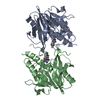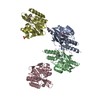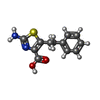[English] 日本語
 Yorodumi
Yorodumi- PDB-8hyb: Crystal structure of B1 IMP-1 MBL in complex with 2-amino-5-phene... -
+ Open data
Open data
- Basic information
Basic information
| Entry | Database: PDB / ID: 8hyb | ||||||||||||
|---|---|---|---|---|---|---|---|---|---|---|---|---|---|
| Title | Crystal structure of B1 IMP-1 MBL in complex with 2-amino-5-phenethylthiazole-4-carboxylic acid | ||||||||||||
 Components Components | Beta-lactamase | ||||||||||||
 Keywords Keywords | HYDROLASE / Beta-lactamase class B IMP-1 | ||||||||||||
| Function / homology |  Function and homology information Function and homology informationantibiotic catabolic process / beta-lactamase activity / beta-lactamase / periplasmic space / response to antibiotic / zinc ion binding Similarity search - Function | ||||||||||||
| Biological species |  | ||||||||||||
| Method |  X-RAY DIFFRACTION / X-RAY DIFFRACTION /  SYNCHROTRON / SYNCHROTRON /  MOLECULAR REPLACEMENT / Resolution: 2.193 Å MOLECULAR REPLACEMENT / Resolution: 2.193 Å | ||||||||||||
 Authors Authors | Yan, Y.-H. / Zhu, K.-R. / Li, G.-B. | ||||||||||||
| Funding support |  China, 3items China, 3items
| ||||||||||||
 Citation Citation |  Journal: To Be Published Journal: To Be PublishedTitle: 2-Aminothiazole-4-carboxylic acids as cross-class metallo-beta-lactamase inhibitors by mimicking beta-lactam hydrolysate binding Authors: Yan, Y.-H. / Zhu, K.-R. / Yang, L.-L. / Li, G.-B. | ||||||||||||
| History |
|
- Structure visualization
Structure visualization
| Structure viewer | Molecule:  Molmil Molmil Jmol/JSmol Jmol/JSmol |
|---|
- Downloads & links
Downloads & links
- Download
Download
| PDBx/mmCIF format |  8hyb.cif.gz 8hyb.cif.gz | 185 KB | Display |  PDBx/mmCIF format PDBx/mmCIF format |
|---|---|---|---|---|
| PDB format |  pdb8hyb.ent.gz pdb8hyb.ent.gz | 147.5 KB | Display |  PDB format PDB format |
| PDBx/mmJSON format |  8hyb.json.gz 8hyb.json.gz | Tree view |  PDBx/mmJSON format PDBx/mmJSON format | |
| Others |  Other downloads Other downloads |
-Validation report
| Summary document |  8hyb_validation.pdf.gz 8hyb_validation.pdf.gz | 1.6 MB | Display |  wwPDB validaton report wwPDB validaton report |
|---|---|---|---|---|
| Full document |  8hyb_full_validation.pdf.gz 8hyb_full_validation.pdf.gz | 1.6 MB | Display | |
| Data in XML |  8hyb_validation.xml.gz 8hyb_validation.xml.gz | 33.4 KB | Display | |
| Data in CIF |  8hyb_validation.cif.gz 8hyb_validation.cif.gz | 45.7 KB | Display | |
| Arichive directory |  https://data.pdbj.org/pub/pdb/validation_reports/hy/8hyb https://data.pdbj.org/pub/pdb/validation_reports/hy/8hyb ftp://data.pdbj.org/pub/pdb/validation_reports/hy/8hyb ftp://data.pdbj.org/pub/pdb/validation_reports/hy/8hyb | HTTPS FTP |
-Related structure data
| Related structure data |  8hycC C: citing same article ( |
|---|---|
| Similar structure data | Similarity search - Function & homology  F&H Search F&H Search |
- Links
Links
- Assembly
Assembly
| Deposited unit | 
| ||||||||
|---|---|---|---|---|---|---|---|---|---|
| 1 | 
| ||||||||
| 2 | 
| ||||||||
| 3 | 
| ||||||||
| 4 | 
| ||||||||
| Unit cell |
|
- Components
Components
-Protein , 1 types, 4 molecules ABCD
| #1: Protein | Mass: 24205.635 Da / Num. of mol.: 4 Source method: isolated from a genetically manipulated source Source: (gene. exp.)   |
|---|
-Non-polymers , 5 types, 164 molecules 








| #2: Chemical | ChemComp-ZN / #3: Chemical | ChemComp-5ZX / #4: Chemical | ChemComp-ACT / #5: Chemical | ChemComp-SO4 / | #6: Water | ChemComp-HOH / | |
|---|
-Details
| Has ligand of interest | Y |
|---|
-Experimental details
-Experiment
| Experiment | Method:  X-RAY DIFFRACTION / Number of used crystals: 1 X-RAY DIFFRACTION / Number of used crystals: 1 |
|---|
- Sample preparation
Sample preparation
| Crystal | Density Matthews: 2.66 Å3/Da / Density % sol: 53.71 % |
|---|---|
| Crystal grow | Temperature: 293 K / Method: vapor diffusion, hanging drop Details: 0.1M Sodium acetate, pH 4.5, 0.2 M Lithium sulfate, 20%-28% (v/v) Polyethylene glycol 8000 |
-Data collection
| Diffraction | Mean temperature: 195 K / Serial crystal experiment: N |
|---|---|
| Diffraction source | Source:  SYNCHROTRON / Site: SYNCHROTRON / Site:  SSRF SSRF  / Beamline: BL19U1 / Wavelength: 1 Å / Beamline: BL19U1 / Wavelength: 1 Å |
| Detector | Type: DECTRIS PILATUS3 X CdTe 1M / Detector: PIXEL / Date: Apr 17, 2020 |
| Radiation | Protocol: SINGLE WAVELENGTH / Monochromatic (M) / Laue (L): M / Scattering type: x-ray |
| Radiation wavelength | Wavelength: 1 Å / Relative weight: 1 |
| Reflection | Resolution: 1.38→19.41 Å / Num. obs: 134737 / % possible obs: 99.93 % / Redundancy: 6.11 % / CC1/2: 0.999 / Rmerge(I) obs: 0.105 / Net I/σ(I): 7.1 |
| Reflection shell | Resolution: 2.06→2.36 Å / Redundancy: 2.48 % / Rmerge(I) obs: 0.699 / Num. unique obs: 20554 / % possible all: 99.93 |
- Processing
Processing
| Software |
| ||||||||||||||||||||||||||||||||||||||||||||||||||||||||
|---|---|---|---|---|---|---|---|---|---|---|---|---|---|---|---|---|---|---|---|---|---|---|---|---|---|---|---|---|---|---|---|---|---|---|---|---|---|---|---|---|---|---|---|---|---|---|---|---|---|---|---|---|---|---|---|---|---|
| Refinement | Method to determine structure:  MOLECULAR REPLACEMENT / Resolution: 2.193→19.342 Å / SU ML: 0.24 / Cross valid method: THROUGHOUT / σ(F): 1.85 / Phase error: 27.79 / Stereochemistry target values: ML MOLECULAR REPLACEMENT / Resolution: 2.193→19.342 Å / SU ML: 0.24 / Cross valid method: THROUGHOUT / σ(F): 1.85 / Phase error: 27.79 / Stereochemistry target values: ML
| ||||||||||||||||||||||||||||||||||||||||||||||||||||||||
| Solvent computation | Shrinkage radii: 0.9 Å / VDW probe radii: 1.11 Å / Solvent model: FLAT BULK SOLVENT MODEL | ||||||||||||||||||||||||||||||||||||||||||||||||||||||||
| Refinement step | Cycle: LAST / Resolution: 2.193→19.342 Å
| ||||||||||||||||||||||||||||||||||||||||||||||||||||||||
| Refine LS restraints |
| ||||||||||||||||||||||||||||||||||||||||||||||||||||||||
| LS refinement shell |
|
 Movie
Movie Controller
Controller


 PDBj
PDBj





